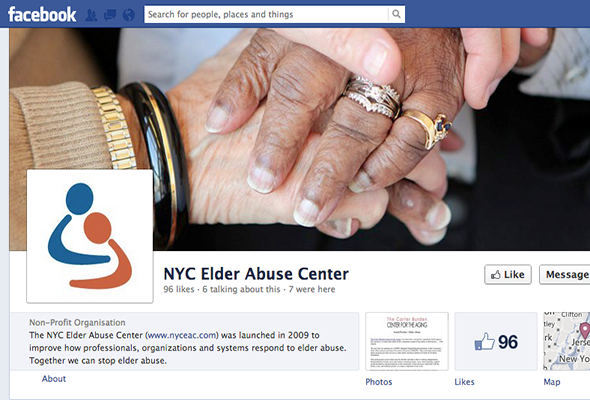
With approximately 77 million baby boomers moving into the older age bracket — New York City’s Department of Planning estimates that by 2030 there will be 1.8 million people over the age of 60 in the city — there is an increasing number of vulnerable seniors becoming elder abuse victims. The bleak economic environment has also given rise to elder financial abuse, the most commonly occurring type of abuse in New York State.
The New York City Elder Abuse Center (NYCEAC) launched a new social media initiative last month, hoping to raise public awareness and facilitate better communication among organizations and agencies dealing with abuse cases.
“We do a lot of training and writing on elder abuse and neglect, but now with these social media vehicles, it could really further the engagements,” said Risa Breckman, social worker and deputy director of the NYCEAC. “We thought we should really be out there and having these conversations online.”
The NYCEAC hopes to establish itself as an expert resource on elder abuse and exploitation, and broaden the conversation on elder justice. It also wants to educate professionals working in this field by offering content in a variety of ways on a range of topics.
Martha Pollack, director of the Jewish Association Serving the Aging’s elder abuse program welcomed this initiative. “ Many younger seniors, those around 60 years of age, are net-savvy and these platforms are a good way for them to stay informed,” she said. “Even in the case of adults who do not use the Internet, their children can use these social media outlets as resources.”
The NYCEAC was created in 2009 through a partnership between the geriatrics and gerontology division of the Weill Cornell Medical College, the Weinberg Center and the New York City Elder Abuse Network. Apart from acting as a conduit for elder abuse discussions, the NYCEAC also seeks to lobby for legislation that protects the city’s older residents.
A 2011 report titled “Under the Radar: New York State Elder Abuse Prevalence Study,” by the New York City Department for the Aging, the Weill Cornell Medical Center and Lifespan of Greater Rochester, Inc., showed New York City to have the highest rate of documented elder abuse cases, at 3.79 per 1000 older adult residents. The NYCEAC website defines elder abuse as: “A single or repeated act, or lack of appropriate actions, which causes harm, risk of harm, or distress to an individual 60 years or older and occurs: within any relationship where there is an expectation of trust…” There are several forms of abuse such as emotional, sexual, physical and financial.
As part of the social media initiative, the NYCEAC created its online profiles on Facebook, LindkedIn, Slideshare and Twitter, with their director, Mark Lachs (@DrMarkLachs) tweeting about the Center’s activities. So far, the Center’s LinkedIn profile has 31 followers, while its Facebook page has just under 100 “likes”.
Debra Askanase of Community Organizer 2.0, who was hired as a consultant on the social media initiative, trained the staff on the best ways to use these tools.
“Much of the training was on understanding the social culture around these channels being used,” said Askanase. “We also looked at the analytics behind them like Facebook Insights, Google Analytics and other backend resources and at collaborative tools like Google docs.”
“Since we’ve launched the blog website views have gone up; referrals from social media to the website have gone up 400 percent, most of them go to the blog,” she said.
Still, Derek Tutschulte, social media coach at the City University of New York (CUNY) Graduate School of Journalism, cautioned against certain mistakes. “The most common mistake organizations make is that they don’t publish or communicate enough via social media and they expect to become popular merely by having a profile online,” he said.
Another thing to avoid, Tutschulte said, is merely parroting information available elsewhere on the Internet, or expressing extreme opinions on a topic.
Apart from social media profiles, the NYCEAC also has an Elder Justice Dispatch Blog written by staff members, focusing on issues and topics relevant to elder abuse. A recent post, a two-part blog on the health concerns of an elder abuse victim, invited readers to share what they thought had happened to the victim after presenting a brief overview of the facts in the first post. The second blog post then dissected the problem, discussing the readers’ professional opinion. A Visual Podcast Series, usually as 10-minute interviews with professionals in the field of elder abuse, is also produced.
“All our activity on these various platforms actually brings people to the site,” said Askanase, “and we hope, over the next six months, this becomes a place for conversation and resources where a community really starts to form.”